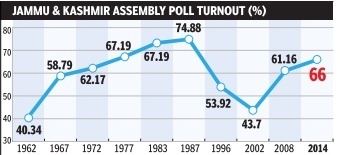Jammu and Kashmir: Elections, 2014 (Assembly, LS)
This is a collection of articles archived for the excellence of their content. |
Terrorists backed by Pakistan kill civilians across Kashmir to disrupt polls in December, 2014
Saleem Pandit, December 06 2014
Four terror attacks rocked Kashmir as Pakistan-backed militants struck a fortified military camp at Uri in Baramulla district as well as police and civilian targets in three other districts. At least 21 have been killed, among them eight soldiers, including the commanding officer in Uri, three policemen, two civilians and the remaining militants. The attacks in Uri, Srinagar, Shopian and Pulwama were seen aimed at disrupting the state elections which have witnessed record voter turnouts despite threats. The attacks came a day after Jamaatud-Dawa chief Hafiz Saeed, speaking in Lahore, rejected the J&K polls, saying they we are no substitute to plebiscite.
2014- Assembly elections
2014: Voter turnout is highest in J&K in 25 years The Times of India
Dec 21, 2014 Describing 2014 as a year of record high voter turnouts, the Election Commission has said the 66% overall polling in J&K was its highest in the last two and-a-half decades. The turnout at the last assembly poll in Jammu & Kashmir recorded 61.16% polling in the 2008 state polls. EC said the overall turnouts may climb further as the figures for the last phase of polling are only tentative.
During the Lok Sabha poll, 2014, J&K recorded a 49.72% turnout, up from 39.70% clocked in 2009 and 35.2% in 2004.
Terming the latest J&K assembly election as “historic” given its high turnout and peaceful conduct, deputy election commissioner Vinod Zutshi said the state had witnessed the highest turnout in around “two-and-a-half decades”. The highest turnout in J&K, it be recalled, was recorded during the 1987 assembly polls, at a whopping 74.88%. This was slightly higher than the 1983 polling figure of 73.24%.
2014
Dec 24 2014 BATTLEGROUND J&K - CHEMISTRY MISSING IN J&K MATH
BJP got highest vote share in J&K, but 2.2% in Valley Perhaps the most startling statistic from the results of the assembly elections in Jammu & Kashmir is the fact that the BJP has a larger vote share than any other party in the state, its 23% just slightly over the PDP's 22.7%, the NC's 20.8% and the Congress share of 18%. That might suggest that the BJP has done quite well in terms of votes across the state, even if its seats are concentrated in the Jammu region. The truth, however, is more nuanced. The much-anticipated breakthrough for the BJP in the Kashmir valley simply hasn't happened. The party's vote share in this part of the state is a dismal 2.2% despite all the hype surrounding its efforts. More surprisingly, even in the Ladakh region, represented in the Lok Sabha by a BJP MP , the party drew a blank in terms of seats and was a distant second to the Congress in terms of vote share, getting barely 22.1% compared to over 50% for the Congress.
What has boosted the BJP's vote share is really a combination of two factors. First is its impressive showing in the Hindu-dominated seats of the Jammu region. In these 25 seats, it won 22 and garnered a vote share of 48.1%. This, combined with the fact that the region also was the one with the highest turnouts in the state, was enough to make the party's state-wide share reach a healthy tally.
Even so, the BJP's vote share in these elections meant a sharp drop of over nine percentage points from the 32.4% it had won in the April-May Lok Sabha polls. The PDP and Congress too saw their vote shares dropping from the LS levels, though not by as much, while the NC's share rose by almost exactly the same amount as the BJP's fell.
A look at the regional patterns reveals that the overall verdict is really an aggregation of very different contests in different parts of the state.If the BJP was the runaway winner in the Hindu-dominated parts of Jammu, the Muslim-dominated parts of Jammu saw the most even four-cornered race with all four major parties getting between 20% and 28% of the votes and the largest among them, the Congress, winning just five of the 12 seats.
As in Jammu, so also in Kashmir, the contest was not quite the same in the north ern and southern parts of the Valley. The PDP clearly dominated south Kashmir, winning 13 of the 21 seats and garnering a vote share of over 40%. The National Conference, despite winning a healthy 30%-plus of the votes could manage no more than four seats since the 10% gap from the leading party was decisive in a largely bi-polar contest in the region. The Congress finished a distant third with 13.2% of the votes and two seats.
North Kashmir saw a more even battle between the two regional parties, with the NC's 28.2% much closer to the PDP's 34.9%. That was reflected in the seat tallies too, with the NC picking up eight to the PDP's 12.





